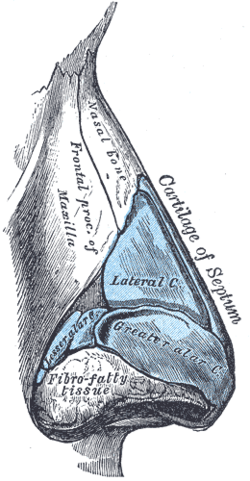Nasal bridge
The nasal bridge is the upper, bony part of the human nose, which overlies the nasal bones.

Nasal bridge is the bony part of the nose, overlying the nasal bones.
Dysmorphology
Low-rooted nasal bridges are closely associated with epicanthic folds. A lower nasal bridge is more likely to cause an epicanthic fold, and vice versa.[1]
A lower or higher than average nasal bridge can be a sign of various genetic disorders, such as fetal alcohol syndrome. A flat nasal bridge can be a sign of Down syndrome (Trisomy 21), Fragile X syndrome, or 48,XXXY variant Klinefelter syndrome.[2]
An appearance of a widened nasal bridge can be seen with dystopia canthorum, which is a lateral displacement of the inner canthi of the eyes.[3] Dystopia canthorum is associated with Waardenburg syndrome.[4]
See also
- Aquiline nose
- Bridge piercing
References
- Montagu, A. (1989) Growing Young N.Y.: McGraw Hill pp. 40
- Klinefelter Syndrome Clinical Presentation
- Genetic Hearing Loss Archived 2013-02-17 at the Wayback Machine from UTMB, Dept. of Otolaryngology. DATE: March 17, 2004. RESIDENT PHYSICIAN: Jing Shen. FACULTY PHYSICIAN: Ronald W. Deskin, MD. SERIES EDITORS: Francis B. Quinn, Jr., MD and Matthew W. Ryan, MD.
- Tagra S, Talwar AK, Walia RL, Sidhu P (2006). "Waardenburg syndrome". Indian J Dermatol Venereol Leprol. 72 (4): 326. doi:10.4103/0378-6323.26718. PMID 16880590.
This article is issued from
Wikipedia.
The text is licensed under Creative
Commons - Attribution - Sharealike.
Additional terms may apply for the media files.